FTA (изд-во). Flexography: Principles And Practices. Vol.1-6
Подождите немного. Документ загружается.

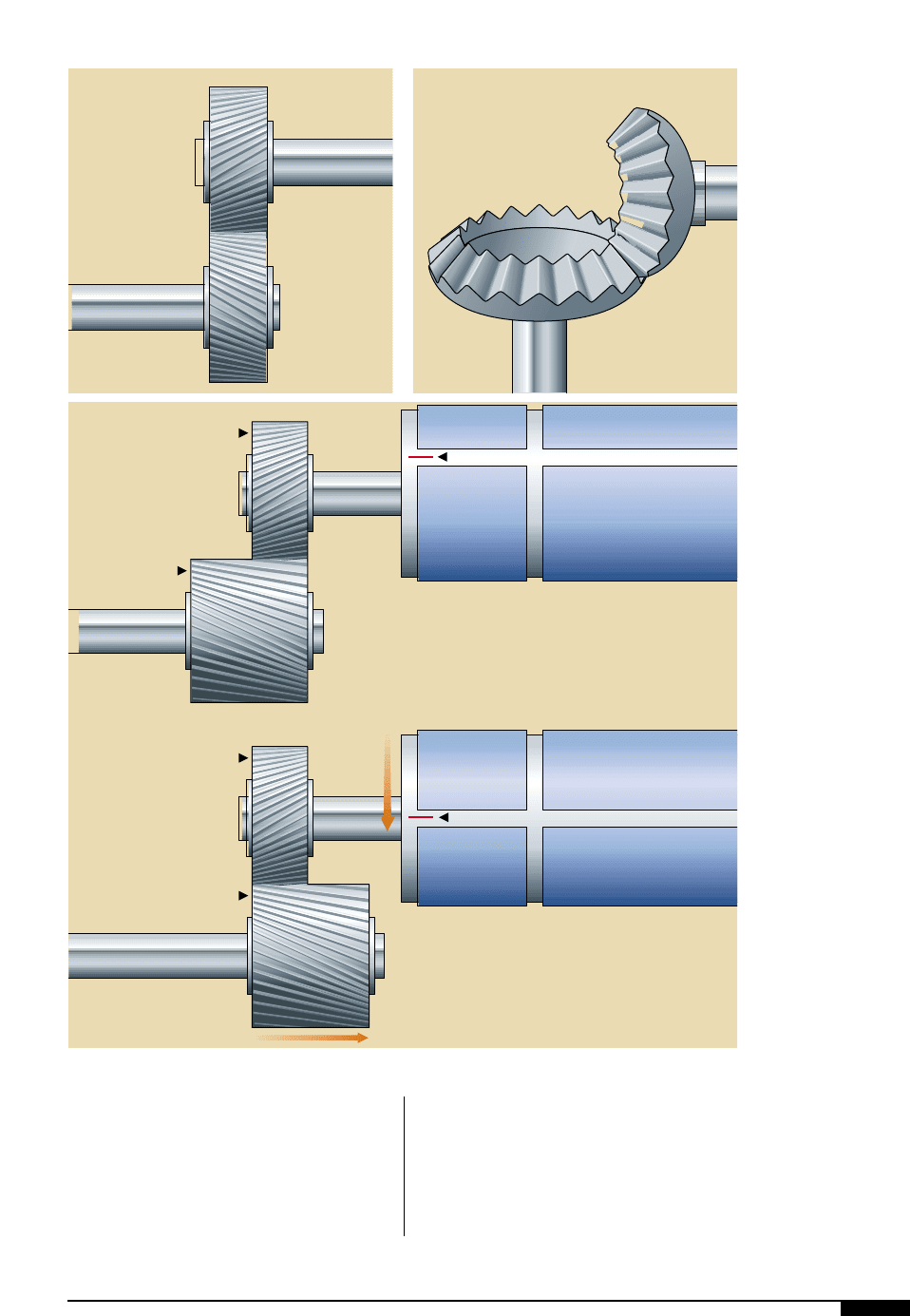
PRESSES AND PRESS EQUIPMENT 133
Helical Gears. The helical gear (Figure
9^
)
has its teeth machined in the form of a helix,
at an angle to the gear body. The angled
teeth permit the helical gears to have multi-
ple teeth engaged at the same time, allowing
higher torque loading. Because of this differ-
ence, helical gears can have finer teeth
(more teeth per inch or centimeter) than
spur gears used to transmit the same torque.
Helical gears are used to transmit power
between two parallel shafts. Helical gears are
the most common type of gearing used to
9^
Helical gears have teeth
machined in the form
of a helix, at an angle
to the gear body. This
allows multiple teeth to
be engaged simultane-
ously, providing higher
torque loading
9&
Helical gear register
control between color
stations is achieved by
lateral movement of the
plate cylinder gear rela-
tive to the impression
cylinder gear.
9*
Bevel gears are used to
transmit power between
two shafts that are at
right angles to each
other.
9^
9*
Helical Gear
Register Mark
Helical Gear
Plate Cylinder
Register Mark
Plate Cylinder
Helical Gear
Helical Gear
9&
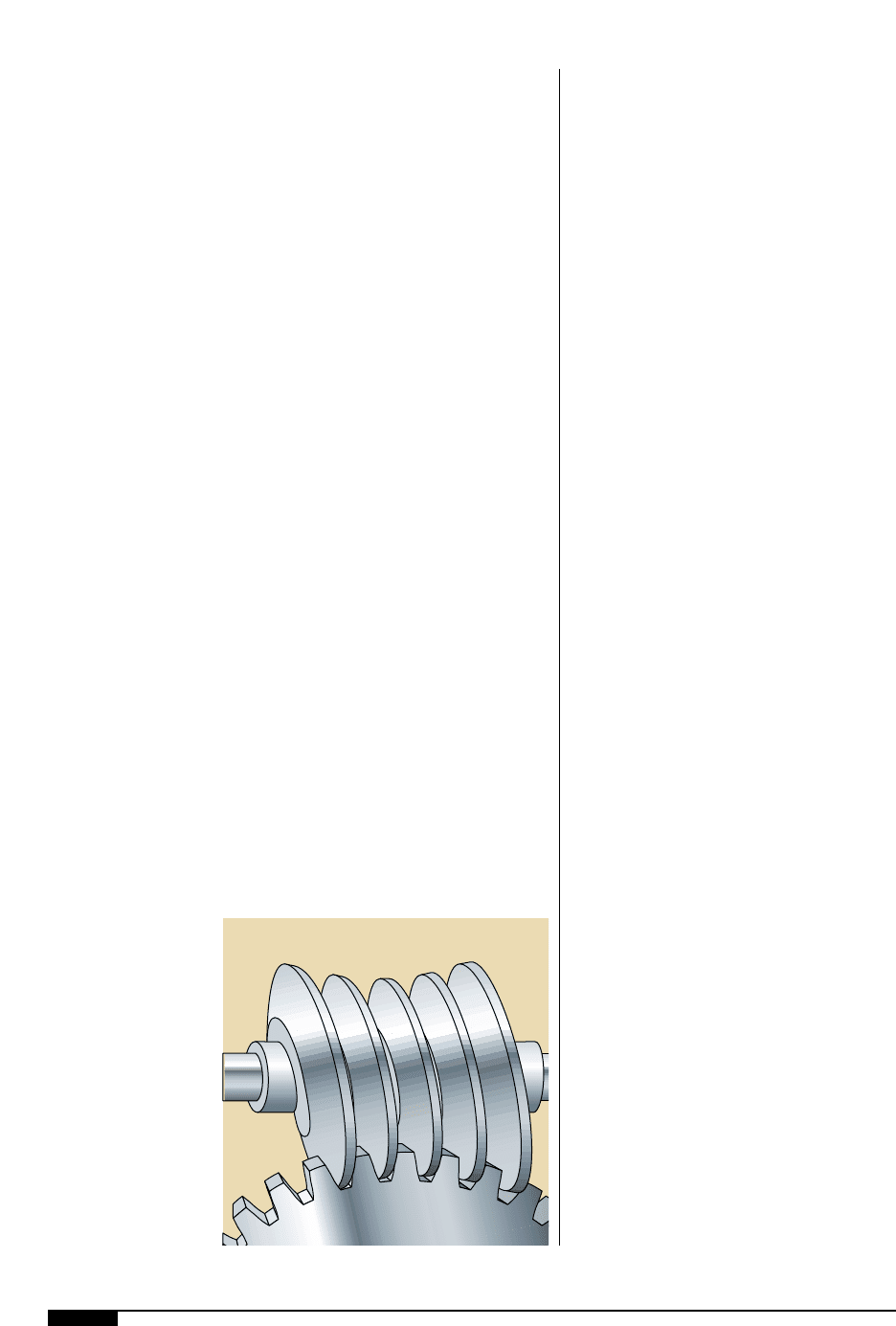
134 FLEXOGRAPHY: PRINCIPLES & PRACTICES
drive flexo plate cylinders. They can have
smaller teeth than spur gears, require less
running clearance and therefore have less
backlash. The angled teeth allow for plate
cylinder color registration without using addi-
tional gears, such as in a differential gearbox.
The fewer gears there are in the drive chain,
the fewer the gear meshing points and, as
each mesh point must contain a degree of
backlash, the smaller the total amount of
backlash. The result of using helical gears is
improved multicolor registration tolerance.
Register phase-shifting between color sta-
tions is achieved by lateral movement of the
plate cylinder gear relative to the impression
cylinder gear (Figure
9&
) The amount of
register correction is a function of the helix
slope angle and the degree of sideways
movement of the gear. This phase shift is
limited to approximately two gear pitches in
either direction on each print station.
Bevel Gears. Bevel gears are used in con-
junction with spur gears as a register con-
trol device on the indirect (swing gear)
impression-drum drive system. They are
incorporated into a differential gearbox,
which can change the register of one plate
cylinder in relation to the other cylinders. A
differential register correction system has
an important advantage over the system
used on direct drive flexo presses in that it
has the ability to rotate the plate cylinder
360° relative to any other cylinder. The heli-
cal gear-color registration system used on
direct drive presses has a limited correction
distance.
Bevel gears are used to transmit power
between two shafts that are at right angles to
each other (Figure
9*
). Many right-angle
gearboxes use two bevel gears, and more
sophisticated gearboxes use four bevel
gears. Bevel gears are almost never used to
directly transmit power to the plate or anilox
rollers, because the shafts of these rollers
are parallel to the impression-roller shafts.
Worm Gears. Worm-gear sets are used as
speed reducers and as right-angle gearbox-
es. A special type of worm-gear system
called the sliding-worm gearbox is used as a
registration device on some types of printing
presses. Worm gears are never used to pro-
pel the plate cylinder on flexo presses, but
they are used in other locations on the press
such as for print deck impression control.
Right-angle, speed-reducing gearboxes
use worm gears, which consist of a worm
shaft and a worm gear (Figure
9(
). The
worm shaft is a cylindrical gear with a spe-
cial screw profile machined to mesh with the
round worm gear. The worm gear is a special
type of round gear with teeth that are con-
cave to match the profile of the teeth on the
worm shaft. More than one tooth may be
meshed together in a worm-gear assembly
and the number of meshed teeth is deter-
mined by the number of helical threads on
the worm. The multiple meshing of teeth
provides maximum torque transmission, as
compared to spur and bevel gears.
Gear Materials. Gears are made from many
different materials. The bull gear, which is
mounted on the impression drum, is usually
made from cast iron with surface-hardened
teeth. The anilox and fountain roller gears are
usually made from steel or hardened cast iron,
although some presses use synthetic gears for
these purposes. The plate-cylinder gears can
9(
The multiple meshing of
teeth in a worm gear
provides maximum
torque transmission, as
compared to spur and
bevel gears.
9(
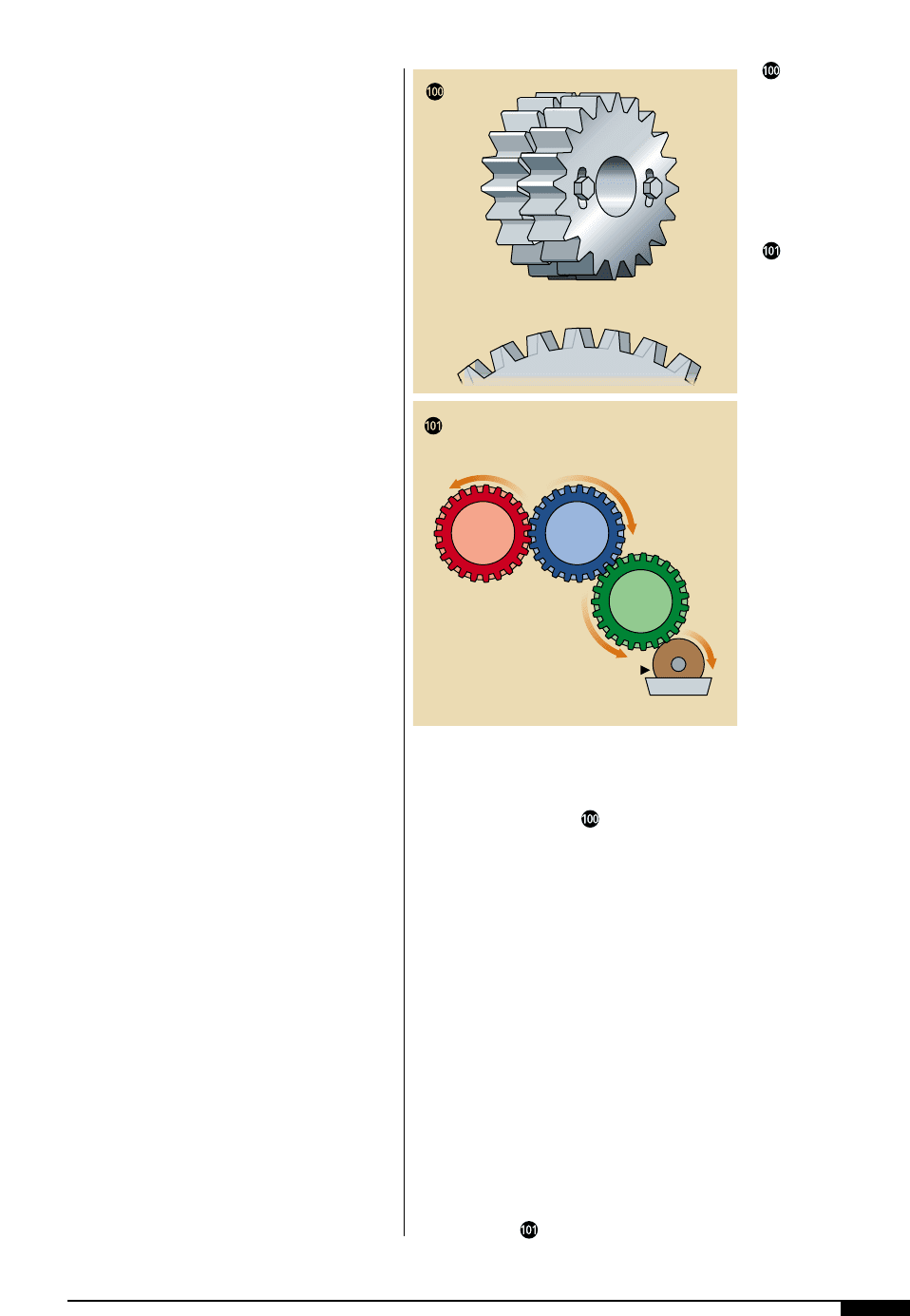
PRESSES AND PRESS EQUIPMENT 135
be made from annealed steel or synthetic
composite materials.
The press manufacturer specifies all gears,
except those for the plate cylinder. The flexo-
grapher can select the type of gear material
for his plate cylinders. The plate-cylinder gear
must be softer than its drive gear, so that it
will wear out first. It is easier to replace a
plate-cylinder gear than a bull gear or other
internal machine gears. Many flexographic
printers prefer synthetic composite or plastic
plate cylinder gears because they help reduce
drive gear vibration and shock waves.
Gear Backlash. There must be a small amount
of space between meshing-gear teeth to
allow them to mesh correctly with sufficient
lubrication and to become engaged and dis-
engaged easily. However, gear wear will
increase this space, and the amount of back-
lash in any set of gears gradually increases.
Excessive backlash is a condition in which
there are larger-than-normal spaces between
successive gear teeth, normally caused by
incomplete meshing or tooth wear. Backlash
is detrimental to high quality printing and can
occur on all types of gears. Backlash allows
the position of the driven cylinder to change
in reference to the drive cylinder, which in
turn causes misregister. The number of gears
in the drive chain multiplies this register
error. Excessive backlash makes it impossi-
ble for the operator to maintain accurate mul-
ticolor register and therefore it is essential to
replace one or both gears in a set that has
developed excessive backlash. Vibrations
associated with backlash also increase plate
bounce and other print quality problems.
There are two types of gears that allow
maintenance personnel to remove all exces-
sive backlash without having to remove or
replace the gear set; these gears are collec-
tively known as anti-backlash gears. An anti-
backlash gear consists of two narrow width
gears whose angular position can be
changed so that there is less space between
each tooth. The screws on the side are loos-
ened, and one thin gear is shifted or offset,
as indicated in Figure , to remove excess
backlash. Another type of anti-backlash gear
is the sliding-worm type, which also allows
for the removal of backlash without removal
of the gears.
Gear Train. The impression cylinder (drum
or roller), the plate cylinder and the anilox
roll all must rotate with exactly the same
surface speed as the web speed in the flexo-
graphic printing process. If any of them is
turning at a slightly different rate, there will
be severe printing problems as well as
excessive plate wear. On a gear-driven press,
matching the speed of these three rollers
with the web is accomplished through the
use of a gear-train power transmission sys-
tem (Figure ). Typically, the power is
An anti-backlash
spur gear is actually
two gears. By changing
the position of one
relative to the other,
tooth spacing can be
altered, thus removing
excess backlash.
On a gear-driven press,
constant speed between
all rollers is ensured
since a main roller
delivers power to all
the rolls.
Counter
Impression
Roll
Driver
Driven
Driven
Plate
Cylinder
Anilox
Roll
Doctor Roll with
Separate Drive
Tooth Offset

136 FLEXOGRAPHY: PRINCIPLES & PRACTICES
delivered from the main motor to the
impression rollers or drum by a single drive
system. A separate gear-train transmission
on each printing deck then delivers the
power from the impression roller to the
printing and anilox rollers; the pitch of the
gears on all three rotating parts is the same.
A separate drive motor generally drives the
inking or fountain roller.
The diameters of all impression, printing
and inking rollers must match the pitch
diameter of the gear that propels them. Pitch
diameter is the diameter at which the gears
operate, not the internal or external diame-
ter of the teeth. The pitch diameter of a gear
is represented by the shaded portion of the
bottom gear in Figure .
It is extremely important that the gears
always operate on their pitch diameter,
because if they do not they can create a
speed mismatch and/or vibrations that will
cause print quality problems and excessive
plate wear. It requires correct printing-plate
mounting and a skillful press operator to set
all of the gears on the moveable anilox and
plate rollers so that they turn on their exact
pitch diameters. If one gear is set past the
pitch diameter, it will cause that roller to
rotate at a slower speed than desired. Con-
versely, if one gear is meshed before the
pitch diameter position, the roller that it dri-
ves will rotate faster than desired.
Repeat-length Increment
On a direct gear driven press, it is not pos-
sible to have a different gear pitch on the
The diameter at which
the gears operate (the
shaded portion on the
bottom gear) is the
pitch diameter of the
gear.
Root Circle
Pitch
Point
Base Circle
Whole Depth
Pitch
Circle
Diameter
Backlash
For a Spur
Gear
Tip Circle
Root Circle
Pitch Circle
Pitch Circle
Bottom
Clearance
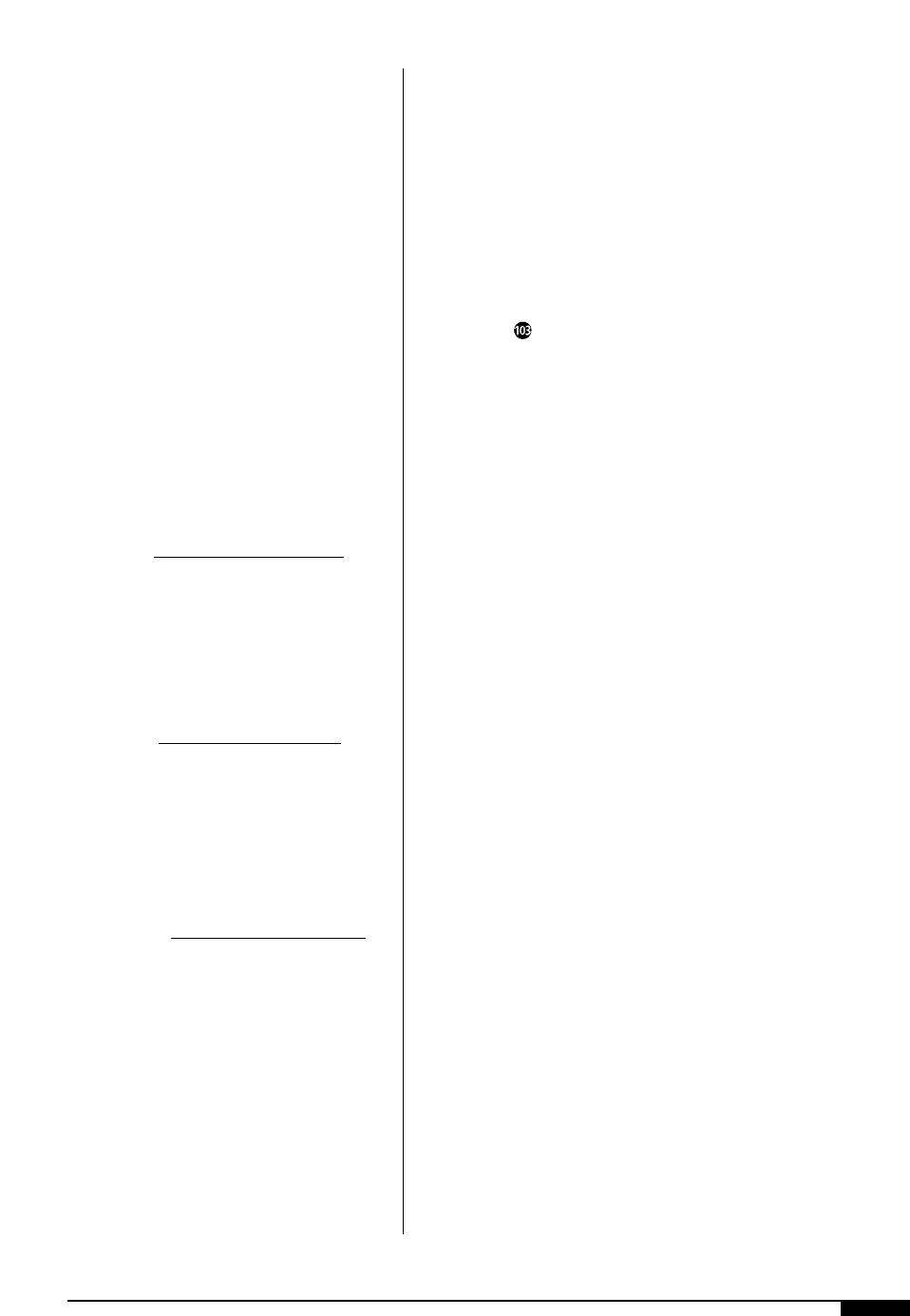
impression drum or rollers than is used to
drive the plate and anilox rollers. Therefore,
the printing repeat-length of a flexo press
can only be changed in increments that are
equal to the pitch of the gearing driving the
plate cylinder.
Gear Measurement. Gear pitch is the distance
measured from the same point on each tooth
of adjacent teeth on a gear, and is measured
along the pitch diameter of the gear.
Incremental increases in printing repeats on
gear-driven presses is restricted to the dis-
tance between the teeth, or gear pitch.
The three methods for specifying gears are:
• Circumferential Pitch. The circumferential
pitch (CP) of a gear is obtained by dividing
the pitch-circle circumference of the gear
by the number of teeth on the gear.
CP PITCH CIRCLE DIAMETER
NUMBER OF TEETH
• Diametral Pitch.The diametral pitch (DP)
of a gear is obtained by dividing the num-
ber of teeth on the gear by the pitch-circle
diameter of the gear in inches (in).
DP NUMBER OF TEETH
PITCH CIRCLE DIAMETER (IN)
• Module Pitch. The module pitch of a gear
is obtained by dividing the pitch circle
diameter of the gear in millimeters (mm)
by the number of teeth on the gear.
MODULE PITCH CIRCLE DIAMETER (MM)
PITCH
NUMBER OF TEETH
The most common gear used on a flexo
press is a 0.25" CP. This gear has spaces of
0.25" between adjacent teeth, measured
along the circumference of the pitch diame-
ter of the gear. The next most common pitch
for flexo gearing has increments between
the teeth of 0.125". The most common
diametral pitch gear is 10. This means there
are 10 teeth for each 1" of diameter and
increments of 0.314" (10/in DP) between
adjacent teeth, as measured along the cir-
cumference of the gear-pitch diameter.
From the above formulae, given the speci-
fication of the gear (Module, DP or CP) and
the number of teeth on the gear, it is a sim-
ple calculation to find the rolling diameter of
the associated cylinder or roll. Tables are
given for reference in the Appendix.
Pitch and Bare Cylinder Diameters. When a
gear is mounted on the shaft of a plate cylin-
der (Figure ), the printing diameter of
the combined plate, mounting system and
bare cylinder must match the pitch diameter
of the gear. Therefore, the printing diameter
is the diameter of the bare plate cylinder
plus twice the thickness of the mounting sys-
tem and plate. For example:
A customer requires an image on a 16"
printed repeat;
• This repeat length would require a 64-
tooth gear with 0.25" CP;
• The pitch diameter of the gear would be
5.093";
• The press uses 0.107" plates mounted
with 0.020" foam tape for a total thick-
ness of 0.127";
• The bare plate cylinder diameter would
be 5.093"(2 0.127")4.839";
• Include 0.002" for plate squeeze (this
will increase the diameter), for a final
diameter of 4.839” (2 0.002")
4.843".
Plate-squeeze Allowance. In order to transfer
ink from one cylinder to another in the flexo
process there must be some squeeze
between the plate and the anilox or impres-
sion roll. If the mounted plates and the plate
cylinder were exactly the same size as the
pitch diameter of the gear there would be
zero printing pressure (plate squeeze) when
the gears were correctly set to turn on their
pitch diameters. The operator would not
obtain good printing across and around the
cylinder and would need to increase the
printing and inking pressure by moving the
PRESSES AND PRESS EQUIPMENT 137
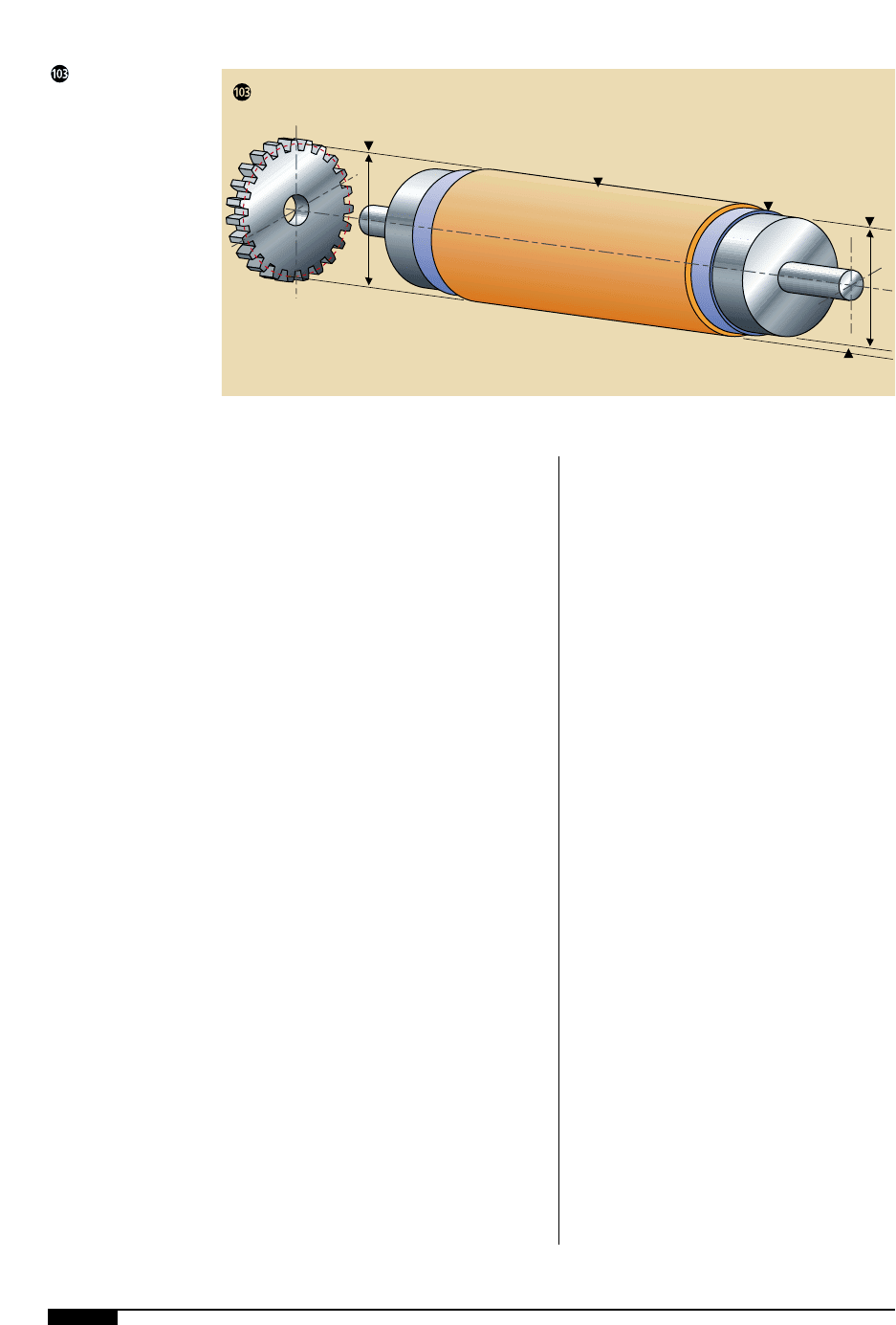
138 FLEXOGRAPHY: PRINCIPLES & PRACTICES
plate cylinder closer to the impression drum
and anilox roller. This move would force the
plate-cylinder gear to over-mesh with the
other gears (running under the pitch diame-
ter), causing vibrations and typically “gear
striped” printing.
To overcome this problem, flexographic
printers allow for plate squeeze, by either
increasing the diameter of their plate cylin-
ders, or by increasing the overall plate
mounting height. The typical plate-squeeze
allowance is approximately 2% of the overall
plate height, including the mounting tape.
Gear Mounting
The gears that drive the plate cylinder and
the anilox roller are mounted on their respec-
tive shafts. The gear driving the anilox roller is
mounted permanently, on a one-way (Sprag)
clutch to allow for continuous rotation of the
anilox when the print cylinder is stationary.
The gear on the plate cylinder shaft can be
mounted permanently or temporarily.
Gears are precise parts of the flexographic
printing system, and if they become damaged
or worn they will affect print quality and reg-
ister. Many presses are equipped with remov-
able plate cylinders and when several sets of
cylinders have the same diameter, to save
money on gear sets, some flexographic print-
ers mount the gear temporarily on the plate
cylinder shaft and then remove it when the
job is finished. However, temporary mount-
ing of plate cylinder gears creates faster
tooth wear (because the gears are used more
frequently) and increases the possibility of
damaging the gears during the transfer from
shaft to shaft.
It is common to see temporarily mounted
gears with excessive wear cause backlash
and poor register, and succumb to broken
teeth, nicks and other damage marks. Any
faults in the plate cylinder gear are transmit-
ted to a second gear on the opposite side of
the plate cylinder, which delivers power to
the anilox roller. For these reasons, it is rec-
ommended that the gear that drives the plate
cylinder be permanently mounted.
A minority of flexographic printers mount
the gear permanently on the plate cylinder
shaft; that gear is used only when the plate
cylinder is printing a job. This method
reduces the wear and potential damage to
the gears. While it may be more expensive to
purchase a gear for each plate cylinder, it
saves money in the long run by reducing
makeready time, color register and generally
improving the print quality.
Gears and In-line Processing
The vast majority of flexographic presses
with diametral pitch (DP) gearing use 10/in
When a gear is
mounted on the shaft
of a plate cylinder, the
printing diameter of
the combined plate,
mounting system and
bare cylinder must
match the pitch
diameter of the gear.
Notice the horizontl
lines extending across
the printing plate align
with the pitch diameter.
Printing
Plate
Bare
Cylinder
Diameter
Cylinder
Undercut
Pitch
Diameter
Mounting
Tape

DP in favor of a metric gear scale module,
even though the press may have been made
or used in countries that use the metric sys-
tem. The reason for this choice is that the U.S.
standard of 10/in DP has been universally
accepted in the paper bag industry. Paper
bags and related products that employ con-
tinuous web in-line processing are made
almost exclusively with diametral-pitch flexo
presses. With the in-line process, when the
printed web is processed in a continuous
motion, the pitch of the gears on a flexo press
must match the gear pitch of the secondary
machine. If the secondary machine has an
intermittent web flow, the gearing on the two
machines does not have to match. Almost all
intermittently fed secondary machines use a
photoelectric detection system to register the
printed web with the secondary finishing.
Because of the difference between the cir-
cular pitch of the respective gears it is
impossible for a flexo press with circumfer-
ential pitch gears to match the printed image
length of another flexo press with diametral
pitch gears, and vice versa. In addition,
diametral pitch gears and circumferential
pitch gears are not interchangeable.
Dual-gear Systems
One of the most difficult decisions to
make when purchasing a flexo press is the
selection of the gear pitch, or the repeat
increments, of the press. Most flexo presses
can only be purchased with one gear system,
for example 0.25" CP, 10/in DP or 5 mm mod-
ule. A few common impression flexo presses
are built with dual gearing; that is, they can
print in either of two gear pitch (increment)
systems, such as 0.25" and 10/in DP, or 5 mm
module and 4/cm pitch. The impression
cylinder must have a diameter that equals
the pitch diameter of the gears used to turn
them. If a dual pitch of 0.25" and 10/in DP
was desired on a direct-drive press, the
impression cylinder might have a 60.001"
diameter and a 188.5" circumference. The
bull gear used to turn the impression cylin-
der would have 754 teeth .025" CP. The cy-
linder would have a second bull gear 600
tooth 10/in DP with a 188.52" circumference,
attached to the first one. Both of these gears
would have approximately the same pitch
diameter as that of the impression cylinder
(CP gear = 60.001" diameter; DP gear =
60.008" diameter). With dual-gear systems,
the choice of impression cylinder diameter
must always be a compromise between the
combination of CP and DP gear diameters.
Central-Impression Press Drives
For CI presses there are essentially two
types of gear drives, the direct drive and
the quadrant drive, sometimes called a
swing gear.
Direct Drive. In the direct drive, a large bull
gear is usually mounted on the outside of the
frame, with a pitch diameter equal to the
diameter of the central impression cylinder.
Typically the bull gear is a helical gear. The
plate cylinder gear, also a helical gear, is fas-
tened to a female spline and the assembly is
attached to a circumferential register mecha-
nism. A male spline fixed to the plate cylin-
der journal will fit inside the female spline.
With this arrangement, the plate-cylinder
gear can slide back and forth on the male
spline to effect the circumferential register
without affecting the plate cylinder’s side reg-
ister. The opposite end of the plate cylinder is
fastened to the side register mechanism.
A direct-geared press maintains good print
register from one color to the next. This reg-
istration accuracy is possible because there
are fewer gears in the gear train and any
inaccuracies machined into the gear train
will repeat themselves on the same tooth of
each color station.
Direct-geared presses also have several
disadvantages. Since the central-impression
cylinder diameter is usually locked into the
pitch diameter of the bull gear, any damage
to the surface of the cylinder once meant
PRESSES AND PRESS EQUIPMENT 139
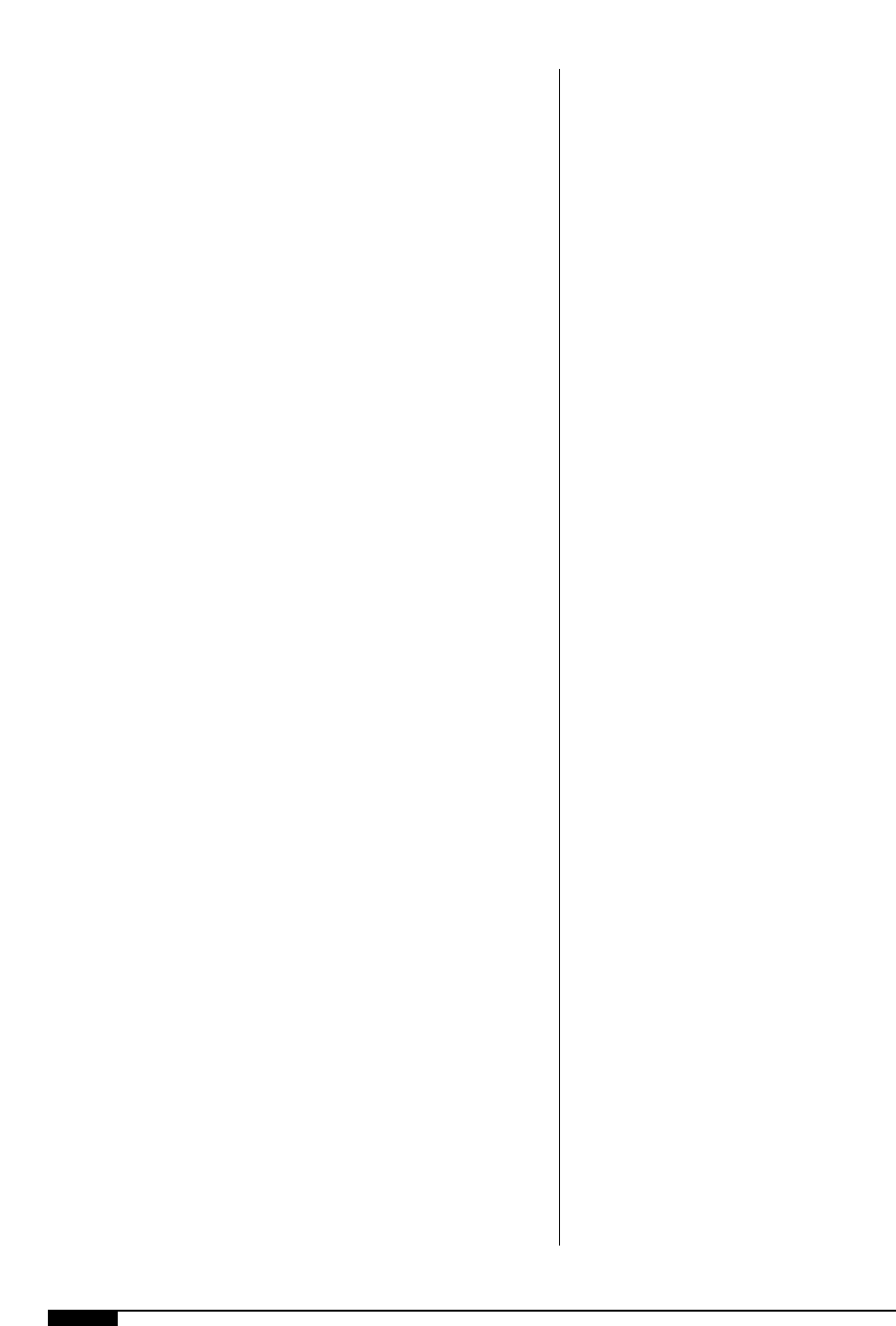
140 FLEXOGRAPHY: PRINCIPLES & PRACTICES
serious modifications to the gear system.
Today, there are ways to repair the drum sur-
face quite satisfactorily.
The plate cylinder’s impression setting is
made to accommodate the web thickness
and any plate variation. Once the ultimate
impression setting has been achieved, the
amount of backlash between the plate cylin-
der and the bull gear is a factor that must be
accepted. There are times when this excess
backlash can cause bounce problems.
Because of the amount of hardware
involved in driving the plate cylinder, on
some press designs the job changeover time
could be slightly longer on a direct-geared
press. To overcome these productivity prob-
lems, spare plate-cylinder gears are recom-
mended. Mounting them on the cylinder in a
pre-makeready area eliminates setup times.
Quadrant-geared Press. On a quadrant- or
swing-geared press, the bull gear does not
come directly in mesh with the plate cylinder
gear. The bull gear is still a helical gear but, in
this case, a pinion gear mounted on a cross-
drive shaft (usually inside the frame) drives a
compound spur gear on the outside of the
frame. A spur-type swing gear then meshes
with the compound gear after the impression
of the plate cylinder has been made.
Circumferential register is achieved by lat-
eral adjustment of the cross-drive shaft. The
pinion helical gear will be forced to rotate on
the bull helical gear, while the compound
spur gear will simply slide back and forth on
the swing gear. The plate cylinder gear is
clamped directly to the plate cylinder jour-
nal. Very few of this type of CI press are
being manufactured today.
There are a couple of advantages to this
type of press. The backlash between the plate
cylinder and the swing gear can be mini-
mized. The impression cylinder diameter is
not locked in as tightly to the bull gear pitch
diameter in the event of drum damage. The
positioning of the gears eliminates the need
for modifying the gear train for each setup.
Also, the elimination of the circumferential
register mechanism associated with a direct-
geared press streamlines plate cylinder instal-
lation. These advantages can result in shorter
setup time on a quadrant-geared press.
The quadrant-geared press has some
notable disadvantages as well. The register
between the groups of print stations on
either side of the press cannot be maintained
as closely as on a direct-geared press due to
the location of the pivot point of the swing
gear assembly. But register between the indi-
vidual print stations within the group can be
maintained with greater register accuracy.
Line-shaft Drives
A line-shaft driven press has a distinct
advantage over straight gear train-driven
machines in that gear backlash from print
unit to print unit is not cumulative. A rigid
line shaft drives each printing cylinder
through a worm or bevel type right angle
gearbox. If one discounts some slight tor-
sion forces on the line shaft, it becomes
apparent that only one gear backlash per
printing unit enters into account. In theory
this means that the gear backlash of only
one printing unit determines the overall
print register tolerances.
Digital-servo Drive
The newest approach in drive technology
on printing machines is the servo drive,
whereby each printing unit has a separate
drive motor, or motors, that are controlled
electronically to rotate at a synchronized
speed with each other. With this technology,
the angular position of the print cylinders
can be controlled with incredible accuracy.
The scale of register accuracy obtained with
these digitally controlled systems is in the
region of thousandths of an inch.
Some manufacturers go as far as driving
every shaft on each printing unit with a sep-
arate motor, while others have one motor
per printing unit.
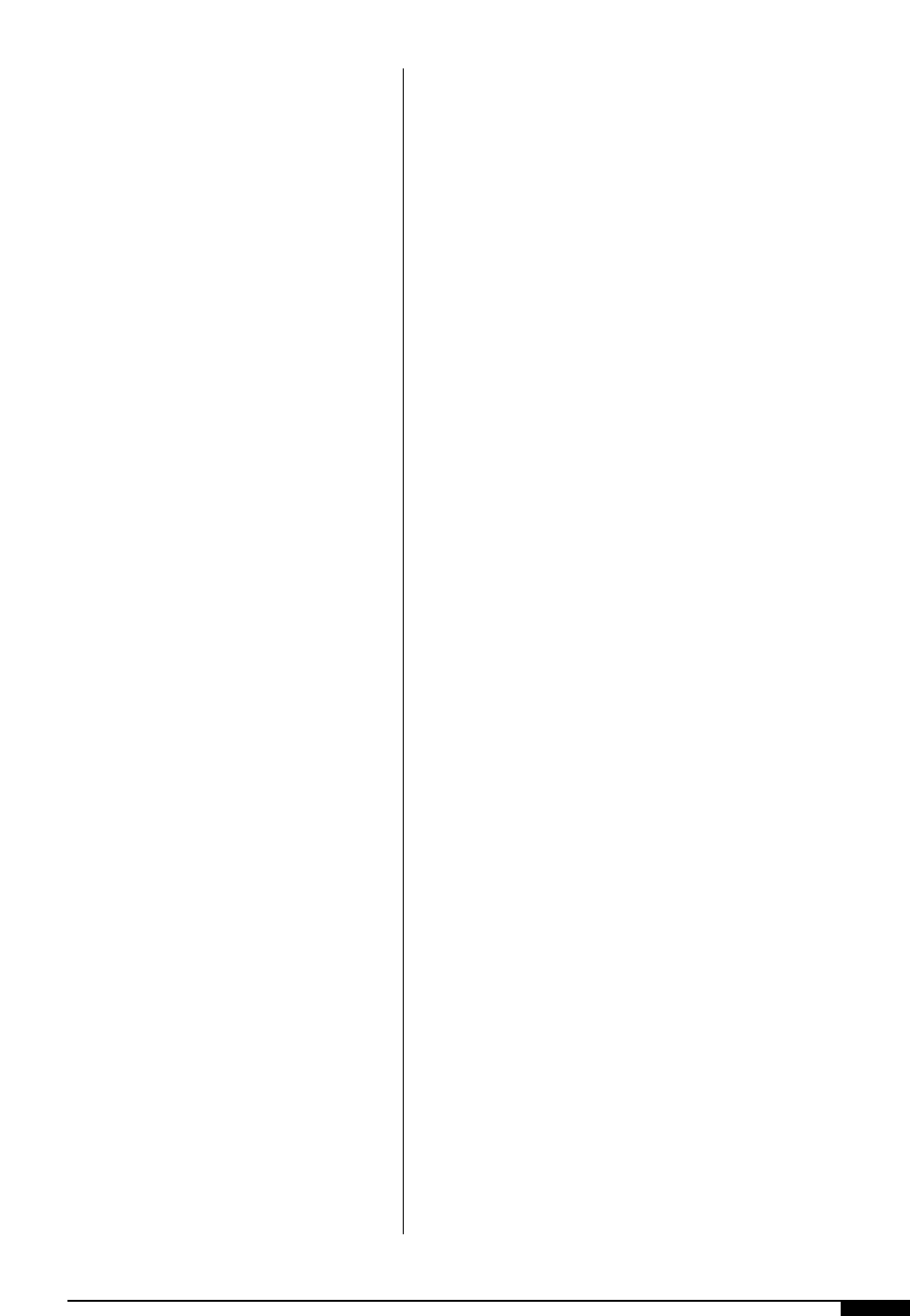
Servo-drive technology has truly opened
new horizons in the flexibility of flexograph-
ic printing presses. For example, digitally
controlled automatic print registration is
common and, theoretically, repeat lengths
are infinitely variable.
BEARINGS
Webster’s defines a bearing as an object,
surface or point that supports, or a machine
part in which (as a journal or pin) turns
another part. From an engineering stand-
point, a bearing is a device that accepts
motion, combats friction and wear, and sup-
ports the load.
Bearings are of two design groups: plain
(sleeve type) and rolling-element (anti-fric-
tion), with many variations in each group.
A plain or sleeve bearing accepts motion
directly on the stationary support. Friction
occurs between the two bearing surfaces or
within a lubricating film between surfaces.
The rolling element bearing is one in which
motion and load are accepted by rolling ele-
ments located between a moving element
and a stationary support element. Rolling ele-
ment bearings generally offer a wide range of
features and performance characteristics.
Plain-sleeve Bearings
A plain bearing is a simple device for pro-
viding support and radial positioning, while
permitting rotation of a shaft. It is the oldest
bearing device known to man. A plain bear-
ing provides simplicity, low cost and short
distance from shaft centerline to bearing
base. It is usually limited to heavy radial
loads and slow-to-moderate speeds. When
properly installed and with correct lubrica-
tion, excellent bearing life will result.
Plain bearings are generally made of a
bronze alloy, and selection of a proper alloy
for a given purpose is very important. In the
selection of the bearing alloy, it is necessary
that the service conditions and operating
factors, such as speeds, loads, operating
temperatures, lubrication and the presence
of foreign materials, first be analyzed. Only
then should the bearing alloy be selected, so
that its outstanding properties will be to the
greatest advantage.
A plain-sleeve bearing is inherently quiet in
operation because it has no moving parts.
With proper selection, installation and lubri-
cation, it does not fail suddenly. Wear is grad-
ual, and replacement of worn bearings can
be scheduled when equipment is normally
idle. Sleeve bearings, like all other bearings,
must be properly selected and used with con-
trol of shaft tolerances, housings, mounting
or installation procedures and lubrication.
Bearing alloy selection is generally a com-
promise of the following essential character-
istics:
• conformability;
• wear resistance;
• coefficient of friction;
• load carrying capacity;
• resistance to pounding; and
• fatigue resistance.
Plain-sleeve bearings find limited use on
modern flexographic presses. They are com-
monly used as plate cylinder bearings,
although the recent trend has been toward
anti-friction needle bearings. Some central
impression presses use plain bearings to
support the impression cylinder. Plain bear-
ings are commonly used in the bore of idler
gears and gear trains where limited space
restricts the use of anti-friction bearings.
The sleeve bearing, when used for plate
cylinders or central impression cylinders,
must be fitted with precision accuracy. As
with all bearings, the outside diameter must
be concentric with the inside diameter, oth-
erwise, cylinder run-out will occur. Very
careful bearing and shaft alignment is an
absolute necessity. Running clearance must
be proper for trouble-free operation.
Running clearance in sleeve bearings is
PRESSES AND PRESS EQUIPMENT 141
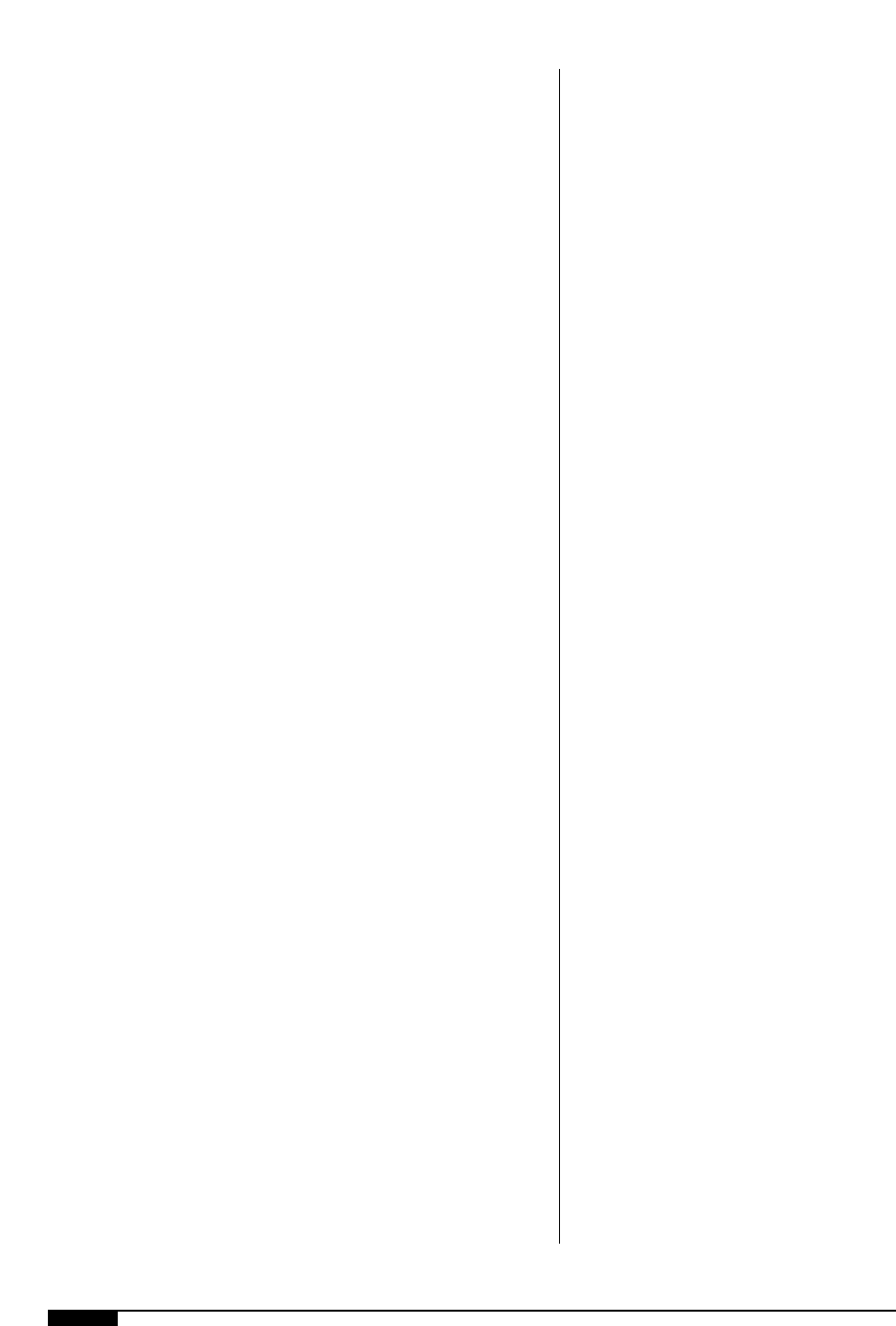
142 FLEXOGRAPHY: PRINCIPLES & PRACTICES
the amount of space between the shaft and
the inside dimension of the bearing. This
space accommodates the lubricant, permits
the formation of the protected oil film pre-
venting metal-to-metal contact when in
operation, and allows for expansion due to
temperature rise. The running clearance for
most cylinder applications is 0.001" to 0.002"
(25 to 50 ).
Assuming a proper bearing selection has
been made, the installation and lubrication
of the bearing are the most critical factors in
its serviceability. Adequate lubrication,
preferably on an automatic program basis,
must be provided. Operating environment,
and to a great degree, common sense and
consideration of the way a bearing functions
will influence the service life of precision
sleeve bearings.
Rolling Bearing
A rolling-element bearing consists of four
basic parts:
• inner ring (inner race);
• outer ring (outer race);
• rollers or balls; and
• retainer or separator.
Three of these parts, the inner ring, the
outer ring, and the rollers or balls, support
the bearing load. The fourth part, the bearing
retainer, serves to position the rolling ele-
ments.
Rolling element bearings can be grouped
into five standard forms, each having a num-
ber of variations. These forms are:
• ball bearing;
• tapered-roller bearing;
• straight-roller bearing;
• ball-thrust bearing; and
• needle-roller bearing.
All of the components and roller element
bearings are made of hardened steel.
Selection of material and control of material
quality are critical in the manufacture of
roller-element bearings. The theoretical
stress obtained in a rolling contact may
exceed 400,000 lb/in
2
. Bearing steel must be
the finest available through current metal-
lurgical technology. It must possess high
strength, toughness, wear resistance and
dimensional stability, and be free from inter-
nal defects.
A modern flexographic press uses many
rolling element bearings. Bearings of all five
standard forms are used. Some press manu-
facturers mount their central impression
cylinder on precision-selected taper roller
bearings that have a total indicated run-out
of less than 0.00017". A tapered-roller bear-
ing is ideally suited to carry all types of load-
ing: radial, thrust and any combination of
both. The rollers and races of a tapered-
roller bearing are built on the principle of a
cone. All lines coincident with the working
surfaces of rollers and races meet at a com-
mon point on the bearing axis. Thus, the
tapered roller bearing handles all loads: radi-
al, thrust and any combination of both.
Most idler rollers rotate on roller bearings.
Depending on use and location, the bearings
may be of open-type construction or sealed
and permanently lubricated. Roller bearings,
for some applications, may be mounted in
housings or pillow blocks.
The idler rolls located in the press dryer
usually require a special type of roller bear-
ing, since, because of their location, they
will be subject to temperatures above their
heat-stabilized range. Standard bearings are
usually heat-stabilized within a range of
275° F to 325° F to minimize growth of the
bearing over a period of time. If bearings are
to operate above this range, then bearings
that have been heat-stabilized at a higher
temperature should be used. Heat stabiliza-
tion will prevent bearing expansion and pos-
sible loosening of the bearing on the shaft.
All motors are fitted with roller element
bearings. These motor bearings generally
have special characteristics, since they are
